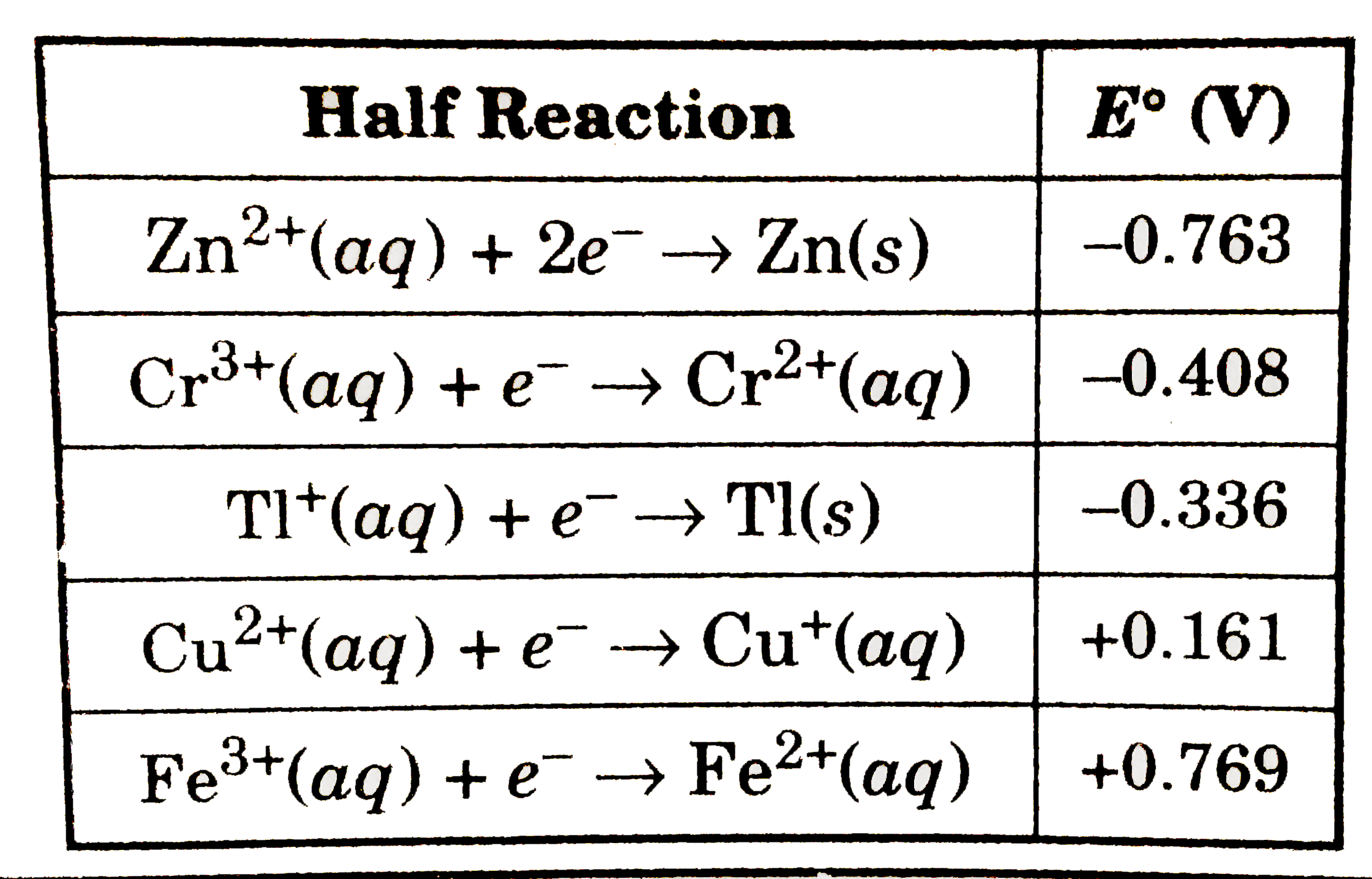Write the overall rendox reaction which takes place in the galvanic cell, Pt(s)∣∣Fe2+(aq),Fe3+(aq)∣∣∣∣MnO−4(aq),H+(aq),Mn2+(aq)∣∣Pt(s)Solution in Tamil
At Anode half cell :5Fe2+(aq)→5Fe2+(aq)+5eo
Overall redox reaction :5Fe2+(aq)+MnO4+8H+(aq)→5Fe3(aq)+Mn3++4H2O1
Topper's Solved these Questions
- SAMPLE PAPER 2 (SOLVED)Book:FULL MARKSChapter:SAMPLE PAPER 2 (SOLVED)Exercise:PART III
Explore 9 Videos
- SAMPLE PAPER 2 (SOLVED)Book:FULL MARKSChapter:SAMPLE PAPER 2 (SOLVED)Exercise:PART IV
Explore 5 Videos
- SAMPLE PAPER 2 (SOLVED)Book:FULL MARKSChapter:SAMPLE PAPER 2 (SOLVED)Exercise:PART IV
Explore 5 Videos
- SAMPLE PAPER 10 (SOLVED)Book:FULL MARKSChapter:SAMPLE PAPER 10 (SOLVED)Exercise:Part-IV
Explore 10 Videos
- SAMPLE PAPER-4 (SOLVED)Book:FULL MARKSChapter:SAMPLE PAPER-4 (SOLVED)Exercise:PART - IV
Explore 11 Videos
Similar Questions
A hydride of 2nd period alkali metal (A ) on reaction with compound of Boron (B ) to give a reducing agent (c ) I dentify A, B and C.
View Solution(a) (i) Describle a method for refining nickel.
(ii) Why group 18 elements are called inert gases ? Write the general electronic configuration of group 18 elements.
(b) (i) Give the uses of helium.
(ii) Ni(II) compounds are more stable than Pt(II) compound.Give reason.
View Solution(a) (i) Describle a method for refining nickel.
(ii) Why group 18 elements are called inert gases ? Write the general electronic configuration of group 18 elements.
(b) (i) Give the uses of helium.
(ii) Ni(II) compounds are more stable than Pt(II) compound.Give reason.
View Solution(a) (i) What is Cementation?
(ii) Write a notes on ionisation enthalpy in p-block elements?
View Solution(i)Explain the concentration of copper pyrites and galena ores.
(ii) Out of Lu(OH)3andLa(OH)3 which is more basic and why?
View SolutionDetermine the potential of the following cell:
Pt|H2(g,0.1¯)|H+(aq,10−3M)∣∣∣
MnO−4(aq,0.1M),Mn2+(aq,0.01M),
H+(aq.0.01M)∣Pt
Given :E0MnO−4∣Mn2+=1.51V
View Solution
Based on the standard reduction potentials above, which reaction(s) is (are) spontaneous?
(P) Cr2+(aq)+Fe3+(aq)→Cr2+(aq)+Fe2+(aq)
(Q) Cu2+(aq)+Fe2+(aq)→Cu2+(aq)+Fe3+(aq)
View SolutionE_(cell)^(@) for the cell: Pt(s) | Fe^(2+)(aq)|Fe^(3+)(aq)||MnO_(4)^(-)(aq), H^(+)(aq)|Mn^(2+)(aq)|Pt is 0.8 volt. [Given: DeltaG_(f)^(@), H_(2)O(l) = -230 kJmol^(-) DeltaG_(f)^(@), Fe^(3+)(aq) = 10.2kJ mol^(-) DeltaG_(f)^(@), Mn^(2+)(aq) = -229 kJmol^(-) DeltaG_(f)^(@), Fe^(2+)(aq) = -84kJmol^(-1)] Determine magnitude of DeltaG_(f)^(@) , MnO_(4)^(-) (aq) in kJ mol^(-)
View SolutionWrite cell reaction of the following cells: (a). Pt|Fe^(2+),Fe^(3+)||MnO_(4)^(-),Mn^(2+),H^(+)|Pt (b). Pt,Cl_(2)|Cl^(-)(aq)||Ag^(+)(aq)|Ag
View Solutionनिम्नलिखित सैलों के लिये सैल अभिक्रिया लीखिए -
(i) Pt,H2(g)∣∣H+(aq)∣∣∣∣Ag+(aq)∣∣Ag(s)
(ii) Ni(s)∣∣Ni2+(aq)∣∣∣∣Cu2+(aq)∣∣Cu(s)
View Solutionदिए गए मानक इलेक्ट्रोड विभव का प्रयोग कर बताइए कि निम्न अभिक्रियाएं सम्भव है या नहीं-
(i) Fe3+(aq) तथा I−(aq)
(ii) Ag+(aq) तथा Cu(s)
(iii) Fe3+(aq)तथा Br−(aq)
(iv) Ag(s) तथा Fe3+(aq)
(v) Br2(aq) तथा Fe2+(aq).
View Solutionनिम्नलिखित अभिक्रियाओं वाले गैल्वेनिक सेल का मानक सेल विभव परिकलित कीजिए।
2Cr(s)+3Cd+2(aq)→2Cr+3(aq)+3Cd(s)
Fe+2(aq)+Ag+(aq)→Fe+3(aq)+Ag(s)
E^0(Cd+2/Cd)= -0.4
E^0(Cr+3/Cr)= -0.74
E^0(Ag+/Ag)= 0.8
E^0(fe+3/fe+2)= 0.77
View SolutionWrite the overall rendox reaction which takes place in the galvanic cell, Pt(s)abs(Fe^(2+)(aq), Fe^(3+)(aq))abs(MnO_(4)^(-)(aq), H^(+)(aq),Mn^(2+)(aq))Pt(s)
View SolutionCalculate the standard cell potentials of galvanic cell in which the following reactions take place. (i) 2Cr(s) + 3Cd^(2+)(aq) to 2Cr^(3+) (aq) + 3Cd (ii) Fe^(2+)(aq) + Ag^(+)(aq) to Fe^(3+)(aq) + Ag(s) Calculate the ΔrG and equilibrium constant of the reactions.
View SolutionUsing the standard electrode potentials given is the Table 1 predict if the reaction between the following is feasible :
(a) Fe3+(aq)andI−(aq)
(b) Ag+(aq)andCu(s)
(c) Fe3+(aq)andCu(s)
(d) Ag(s)andFe3+(aq)
(e) Br2(aq)andFe2+(aq) .
View Solution

